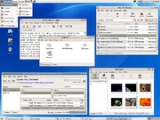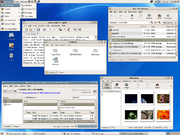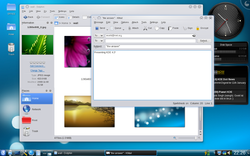
Desktop metaphor
Encyclopedia

Interface metaphor
An Interface metaphor is a set of user interface visuals, actions and procedures that exploit specific knowledge that users already have of other domains. The purpose of the interface metaphor is to give the user instantaneous knowledge about how to interact with the user interface...
which is a set of unifying concepts used by graphical user interface
Graphical user interface
In computing, a graphical user interface is a type of user interface that allows users to interact with electronic devices with images rather than text commands. GUIs can be used in computers, hand-held devices such as MP3 players, portable media players or gaming devices, household appliances and...
s to help users more easily interact with the computer. The desktop metaphor treats the monitor
Computer display
A monitor or display is an electronic visual display for computers. The monitor comprises the display device, circuitry, and an enclosure...
of a computer as if it is the user's desk
Desk
A desk is a furniture form and a class of table often used in a work or office setting for reading or writing on or using a computer. Desks often have one or more drawers to store office supplies and papers. Unlike a regular table, usually only one side of a desk is suitable to sit on . Not all...
top, upon which objects such as document
Document
The term document has multiple meanings in ordinary language and in scholarship. WordNet 3.1. lists four meanings :* document, written document, papers...
s and folders
File folder
A file folder is a kind of folder that holds loose papers together for organization and protection. File folders usually consist of a sheet of heavy paper stock or other thin, but stiff, material which is folded in half, and are used to keep paper documents...
of documents can be placed. A document can be opened into a window
Window (computing)
In computing, a window is a visual area containing some kind of user interface. It usually has a rectangular shape that can overlap with the area of other windows...
, which represents a paper copy of the document placed on the desktop. Small applications called desk accessories
Desk Accessory
A desk accessory is a small helper-type application that can be run concurrently with any other application on the system. Early examples, such as SideKick and Macintosh desk accessories, used special programming models to provide a small degree of multitasking on a system that initially did not...
are also available, such as a desk calculator or notepad, etc.
The desktop metaphor itself has been extended and stretched with various implementations, since access to features and usability
Usability
Usability is the ease of use and learnability of a human-made object. The object of use can be a software application, website, book, tool, machine, process, or anything a human interacts with. A usability study may be conducted as a primary job function by a usability analyst or as a secondary job...
of the computer are usually more important than maintaining the ‘purity’ of the metaphor
Metaphor
A metaphor is a literary figure of speech that uses an image, story or tangible thing to represent a less tangible thing or some intangible quality or idea; e.g., "Her eyes were glistening jewels." Metaphor may also be used for any rhetorical figures of speech that achieve their effects via...
. Hence we find trash cans on the desktop, as well as disks and network volumes (which can be thought of as filing cabinet
Filing cabinet
A filing cabinet is a piece of office furniture usually used to store paper documents in file folders. In the most simple sense, it is an enclosure for drawers in which items are stored. The two most common forms of filing cabinets are blocky files and diagonal files...
s—not something normally found on a desktop). Other features such as menu bar
Menu bar
A menu bar is a region of a screen or application interface where drop down menus are displayed. The menu bar's purpose is to supply a common housing for window- or application-specific menus which provide access to such functions as opening files, interacting with an application, or displaying...
s, task bars, or dock
Dock (computing)
The Dock is a prominent feature of the graphical user interface of the Mac OS X operating system. It is used to launch applications and switch between running applications...
s have no counterpart on a real-world desktop.
History

The first commercial computer that adopted this kind of interface was the Xerox Star
Xerox Star
The Star workstation, officially known as the Xerox 8010 Information System, was introduced by Xerox Corporation in 1981. It was the first commercial system to incorporate various technologies that today have become commonplace in personal computers, including a bitmapped display, a window-based...
.
One of the very first desktop-like interfaces on the market was a program called Magic Desk I built on a cartridge for the Commodore 64
Commodore 64
The Commodore 64 is an 8-bit home computer introduced by Commodore International in January 1982.Volume production started in the spring of 1982, with machines being released on to the market in August at a price of US$595...
home computer
Home computer
Home computers were a class of microcomputers entering the market in 1977, and becoming increasingly common during the 1980s. They were marketed to consumers as affordable and accessible computers that, for the first time, were intended for the use of a single nontechnical user...
in 1983. A very primitive GUI presented a rough sketch of a desktop, complete with telephone, drawers, calculator, etc.
The user made his choices by moving a sprite
Sprite (computer graphics)
In computer graphics, a sprite is a two-dimensional image or animation that is integrated into a larger scene...
of a hand pointing with the use of a joystick
Joystick
A joystick is an input device consisting of a stick that pivots on a base and reports its angle or direction to the device it is controlling. Joysticks, also known as 'control columns', are the principal control in the cockpit of many civilian and military aircraft, either as a center stick or...
and chose options by pushing the firebutton of the joystick. The Magic Desk program featured a typewriter
Typewriter
A typewriter is a mechanical or electromechanical device with keys that, when pressed, cause characters to be printed on a medium, usually paper. Typically one character is printed per keypress, and the machine prints the characters by making ink impressions of type elements similar to the pieces...
machine graphically emulated complete with audio effects, calculator, organiser, and the files could be archived into the drawers of the desktop, right into their folders. A trashcan
Recycle bin (computing)
In computing, the trash is temporary storage for files that have been deleted in a file manager by the user, but not yet permanently erased from the physical media...
was also present.
The first computer to popularise the desktop metaphor over the earlier command line interface was the Apple Macintosh in 1984. The desktop metaphor is ubiquitous in modern-day personal computing; it is found in most desktop environment
Desktop environment
In graphical computing, a desktop environment commonly refers to a style of graphical user interface derived from the desktop metaphor that is seen on most modern personal computers. These GUIs help the user in easily accessing, configuring, and modifying many important and frequently accessed...
s of modern operating systems: Windows
Microsoft Windows
Microsoft Windows is a series of operating systems produced by Microsoft.Microsoft introduced an operating environment named Windows on November 20, 1985 as an add-on to MS-DOS in response to the growing interest in graphical user interfaces . Microsoft Windows came to dominate the world's personal...
as well as Mac OS X
Mac OS X
Mac OS X is a series of Unix-based operating systems and graphical user interfaces developed, marketed, and sold by Apple Inc. Since 2002, has been included with all new Macintosh computer systems...
, Linux
Linux
Linux is a Unix-like computer operating system assembled under the model of free and open source software development and distribution. The defining component of any Linux system is the Linux kernel, an operating system kernel first released October 5, 1991 by Linus Torvalds...
, and other Unix-like
Unix-like
A Unix-like operating system is one that behaves in a manner similar to a Unix system, while not necessarily conforming to or being certified to any version of the Single UNIX Specification....
systems.
BeOS
BeOS
BeOS is an operating system for personal computers which began development by Be Inc. in 1991. It was first written to run on BeBox hardware. BeOS was optimized for digital media work and was written to take advantage of modern hardware facilities such as symmetric multiprocessing by utilizing...
observed the desktop metaphor more strictly than many systems. For example, external hard drives appeared on the ‘desktop’, while internal ones were accessed clicking on an icon
Icon (computing)
A computer icon is a pictogram displayed on a computer screen and used to navigate a computer system or mobile device. The icon itself is a small picture or symbol serving as a quick, intuitive representation of a software tool, function or a data file accessible on the system. It functions as an...
representing the computer itself. By comparison, the Mac OS optionally places all drives on the desktop itself, while in Windows the user can access the drives through an icon labelled "Computer".
Amiga
Amiga
The Amiga is a family of personal computers that was sold by Commodore in the 1980s and 1990s. The first model was launched in 1985 as a high-end home computer and became popular for its graphical, audio and multi-tasking abilities...
terminology for its desktop metaphor was taken directly from workshop jargon. The desktop was called Workbench
Workbench (AmigaOS)
-Overview:Commodore named their Amiga computer's first operating system Workbench 1.0 and continued with the Workbench name until version 3.1, when it was changed to AmigaOS, prompted by Apple renaming their propriety OS from "System" to "MacOS"...
, programs were called tools, small applications (applets) were utilities, directories were drawers, etc.
Icons of objects were animated and the directories are shown as drawers which were represented either open or closed.
As in the Mac OS
Mac OS
Mac OS is a series of graphical user interface-based operating systems developed by Apple Inc. for their Macintosh line of computer systems. The Macintosh user experience is credited with popularizing the graphical user interface...
desktop, an icon for a floppy disk
Floppy disk
A floppy disk is a disk storage medium composed of a disk of thin and flexible magnetic storage medium, sealed in a rectangular plastic carrier lined with fabric that removes dust particles...
or CD-ROM
CD-ROM
A CD-ROM is a pre-pressed compact disc that contains data accessible to, but not writable by, a computer for data storage and music playback. The 1985 “Yellow Book” standard developed by Sony and Philips adapted the format to hold any form of binary data....
would appear on the desktop when the disk was inserted into the drive, as it was a virtual counterpart of a physical floppy disk or CD-ROM on the surface of a workbench.
Paper paradigm
The paper paradigm refers to the paradigmParadigm
The word paradigm has been used in science to describe distinct concepts. It comes from Greek "παράδειγμα" , "pattern, example, sample" from the verb "παραδείκνυμι" , "exhibit, represent, expose" and that from "παρά" , "beside, beyond" + "δείκνυμι" , "to show, to point out".The original Greek...
used by most modern computers and operating systems. The paper paradigm consists of, usually, black text on a white background, files within folders, and a "desktop." The paper paradigm was created by many individuals and organisations, such as Douglas Engelbart
Douglas Engelbart
Douglas Carl Engelbart is an American inventor, and an early computer and internet pioneer. He is best known for his work on the challenges of human-computer interaction, resulting in the invention of the computer mouse, and the development of hypertext, networked computers, and precursors to GUIs...
, Xerox PARC
Xerox PARC
PARC , formerly Xerox PARC, is a research and co-development company in Palo Alto, California, with a distinguished reputation for its contributions to information technology and hardware systems....
, and Apple Computer
Apple Computer
Apple Inc. is an American multinational corporation that designs and markets consumer electronics, computer software, and personal computers. The company's best-known hardware products include the Macintosh line of computers, the iPod, the iPhone and the iPad...
, and was an attempt to make computers more user-friendly by making them resemble the common workplace of the time (with papers, folders, and a desktop). It was first presented to the public by Engelbart in 1968, in what is now referred to as "The Mother of All Demos
The Mother of All Demos
The Mother of All Demos is a name given to Douglas Engelbart's December 9, 1968, demonstration of experimental computer technologies that are now commonplace...
".
From John Siracusa:
Back in 1984, explanations of the original Mac interface to users who had never seen a GUIGuiGui or guee is a generic term to refer to grilled dishes in Korean cuisine. These most commonly have meat or fish as their primary ingredient, but may in some cases also comprise grilled vegetables or other vegetarian ingredients. The term derives from the verb, "gupda" in Korean, which literally...
before inevitably included an explanation of iconIcon (computing)A computer icon is a pictogram displayed on a computer screen and used to navigate a computer system or mobile device. The icon itself is a small picture or symbol serving as a quick, intuitive representation of a software tool, function or a data file accessible on the system. It functions as an...
s that went something like this: "This icon represents your file on disk." But to the surprise of many, users very quickly discarded any semblance of indirection. This icon is my file. My file is this icon. One is not a "representation of" or an "interface to" the other. Such relationships were foreign to most people, and constituted unnecessary mental baggage when there was a much more simple and direct connection to what they knew of reality.
Since then, many aspects of computers have wandered away from the paper paradigm by implementing features such as "shortcuts" to files, hypertext
Hypertext
Hypertext is text displayed on a computer or other electronic device with references to other text that the reader can immediately access, usually by a mouse click or keypress sequence. Apart from running text, hypertext may contain tables, images and other presentational devices. Hypertext is the...
, and non-spatial file browsing. A shortcut (a link to a file that acts as a redirecting proxy, not the actual file) and hypertext have no real-world equivalent. Non-spatial file browsing, as well, may confuse novice users, as they can often have more than one window representing the same folder open at the same time. These and other departures from real-world equivalents are violations of the pure paper paradigm.
See also
- Interface metaphorInterface metaphorAn Interface metaphor is a set of user interface visuals, actions and procedures that exploit specific knowledge that users already have of other domains. The purpose of the interface metaphor is to give the user instantaneous knowledge about how to interact with the user interface...
- History of the GUI
- Desktop environmentDesktop environmentIn graphical computing, a desktop environment commonly refers to a style of graphical user interface derived from the desktop metaphor that is seen on most modern personal computers. These GUIs help the user in easily accessing, configuring, and modifying many important and frequently accessed...
- WIMP (computing)WIMP (computing)In human–computer interaction, WIMP stands for "windows, icons, menus and pointers", denoting a style of interaction using these elements. It was coined by Merzouga Wilberts in 1980...
- Virtual desktopVirtual desktopIn computing, a virtual desktop is a term used with respect to user interfaces, usually within the WIMP paradigm, to describe ways in which the size of a computer's desktop environment is expanded beyond the physical limits of the screen's real estate through the use of software, This saves space...
- Tiling window managerTiling window managerIn computing, a tiling window manager is a window manager with an organization of the screen into mutually non-overlapping frames, as opposed to the more popular approach of coordinate-based stacking of overlapping objects that tries to fully emulate the desktop metaphor.-Xerox PARC:Although the...
- Operating systemOperating systemAn operating system is a set of programs that manage computer hardware resources and provide common services for application software. The operating system is the most important type of system software in a computer system...
- File browser

